OCZ Octane 512 GB Solid State Drive Review

Among SSDs from OCZ there is one very interesting series of products – Octane built on a unique Indilinx Everest controller. We haven’t yet reviewed drives like that therefore it was particularly interesting to see if Octane would become a worthy competitor to popular SSDs on SandForce and Marvell controllers. Especially since OCZ has recently released a new firmware update for their Octane series, which significantly improves their performance.
You may have already heard about solid state drives of the OCZ Octane family which feature their very own Indilinx Everest controller. Every prominent hardware site has already posted an appropriate review. We, unfortunately, can only do so now, over 3 months after the Octane hit the market. Our review of one of the most exciting SSDs that have come about recently has a story of its own. First, the manufacturer waited too much to provide us a test sample, and then, when our review had almost been finished, firmware version 1.13 was released. It brought about a number of dramatic enhancements, so we had to fully retest our Octane.
There is a good side to every experience, though. Thanks to this delay we have an opportunity to tell you about the Octane in its mature form. Now we can talk about the highs and lows of this whole series basing on the practical experience of end users who report no critical failures or shortcomings. That’s a substantial addition to the results of benchmarks because the OCZ Octane is a new platform based on a proprietary controller Everest from the Korean firm Indilinx that has become part of OCZ Technology Group.
This is actually the reason why the Octane is so exciting. Any alternative solution to the crowd of identical SSDs based on the SandForce SF-2281 controller would stand out on the market. Notwithstanding the dozens of companies in SSD business, there are but few brands that can take up the full cycle of developing and manufacturing their own SSDs, starting from the controller and firmware. The premier league of consumer-level SSD makers includes such giants as Intel and Samsung and, with some reservations, Corsair, Crucial and Plextor (which collaborate with Marvell). Recently OCZ Technology has also joined the ranks of full-cycle SSD developers as it has got its own Indilinx Everest controller.
As a matter of fact, the Everest-based family doesn’t have a gap to fill in OCZ’s product line-up. The company used to produce SandForce-based SSDs and offered a full range of products for different price categories even before the Octane. Obviously, they will shift their focus from SandForce- to Octane-based SSDs from now on. As long as this transition takes place, the Octane can be viewed as an alternative to the comparably priced Vertex 3 series. But are they comparable in performance? We’ll try to answer this question in our review.
Indilinx Everest
The Everest is a further development of the good old Indilinx Barefoot controller that used to be successfully employed in SSDs from Corsair, Crucial, OCZ, Patriot and other brands a couple of years ago. Like its predecessor, the new controller is based on the ARM architecture but features a lot of enhancements and improvements. Having two cores clocked at 275 MHz, the Everest boasts much higher computing power. It supports SATA 6 Gbit/s and eight-channel flash memory access. All in all, it seems to be quite competitive as far as its basic specs go.
The Everest is a versatile controller meaning that it supports a wide range of flash memory types including SLC, MLC and TLC NAND flash chips with ONFI 2.x, Toggle 1.x and even asynchronous interface. The data-transfer rate can be as high as 200 MT/s. To optimize memory access, the Everest can be accompanied with up to 512 MB of DDR2 or DDR3 SDRAM cache. With more possible configurations than the SandForce SF-2281, it can be employed in SSDs from different price categories.
One feature which is especially emphasized by the Everest developers is the opportunity to build 1-terabyte SSDs. Each of the controller’s memory access channels supports 16-way interleave across NAND devices. Considering that currently produced 25nm NAND flash dies have 8 GB capacity, the 8-channel access with 16-way interleave equals 1 terabyte of addressable memory.
Well, it must be admitted that the Everest’s abundant functionality is not yet utilized fully. The owner of exclusive rights to the controller, OCZ, has only implemented two typical configurations as yet: with synchronous ONFI 2.2 and with asynchronous MLC flash memory. Yet we are sure to see many different Everest-based products in the future.
OCZ Octane in Detail
By now, OCZ has already announced three series of Everest-based SSDs: Octane, Octane S2 and Petrol. We are going to focus on the Octane series which is positioned as a high-performance one. The other two are compromise solutions: the Octane S2 is meant for older computers with SATA 3 Gbit/s whereas the Petrol is an affordable series. When announcing the Octane, OCZ put a special emphasis on the fact that the storage capacity of the senior Octane model is as high as 1 terabyte. This is a unique feature indeed, yet high-capacity SSDs are expensive and thus can hardly appeal to the average PC user. Fortunately, the Octane is also available in capacities of 128, 256 and 512 GB. The latest version of their specs (significantly redacted after the release of firmware version 1.13) reads like this:

The Octane series doesn’t look very fast compared to SSDs based on second-generation SandForce controllers. For example, the Vertex 3 features higher specified speeds both at sequential operations and when processing 4KB data blocks. On the other hand, the performance of SandForce controllers depends heavily on how well the processed data can be compressed, therefore it wouldn’t be correct to directly compare the specs of the Octane and Vertex 3 series. We’d better wait and see what we have in practical applications.
OCZ provided a 512GB Octane for us to test. Judging by the specs, its performance is not much different from that of the 256GB model. So our test results will be indicative of the latter’s behavior, too. Let’s take a look at our 512GB sample, though.
It comes in a plastic blister wrap with a colorful paper insert.
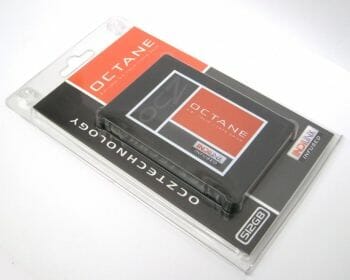
The SSD is hardly different visually from other OCZ products, even those with SandForce controllers. It’s got the same case but the sticker is colored gray and terracotta.
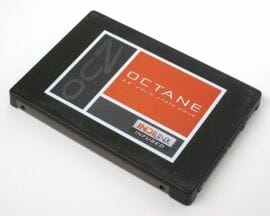
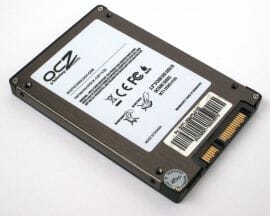
The most interesting things are hidden inside, of course. There are as many as three kinds of chips populating the PCB.
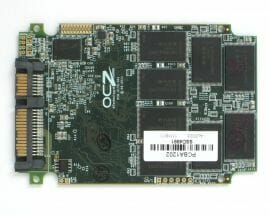
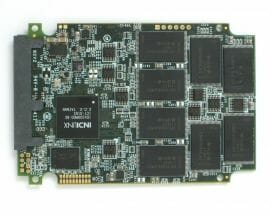
First of all, it is the Indilinx Everest controller itself, labeled IDX300M00-BC.
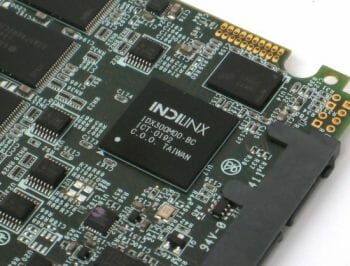
Then, we’ve got NAND flash memory here: 16 chips known as 29F32B08JCME2. Manufactured by Intel, they have 32 GB storage capacity and consist of four 64-gigabit 25nm dies. The flash memory is connected via synchronous ONFI 2.2 interface. Considering that this Octane has a total of 64 NAND devices, the Everest controller can enable 8-way interleave in each channel.
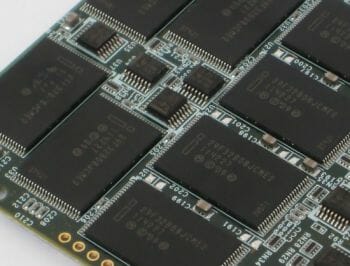
Finally, there are two 2-gigabit DDR3-1600 SDRAM chips from Micron that make up a 512 MB cache.
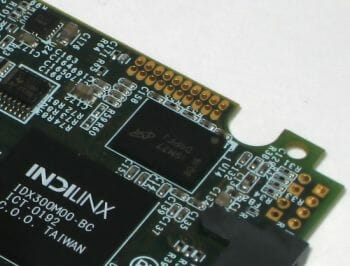
All in all, we have an Everest-based SSD with a 512MB cache and 512 GB storage capacity. It must be noted, however, that you can only use 512 GB out of the true 512 gibibytes. And the SSD will only offer 477 GB in the operating system, the remaining 35 GB being reserved for garbage collection procedures and for replacing failed NAND cells. By the way, this amounts to only 7% of the total capacity whereas SandForce-based SSDs allot 13% for the reserve pool.
OCZ offers the Toolbox utility for working with Octane series SSDs on a low level.
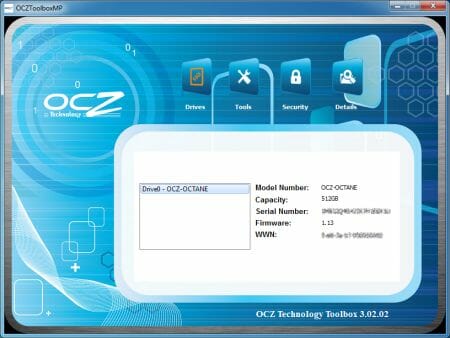
That’s a useful tool considering that ordinary utilities do not work well with Everest-based SSDs. You can use it to update the SSD’s firmware, view its S.M.A.R.T. information and perform a Secure Erase. The utility is not yet polished off and requires Microsoft’s AHCI driver to run.
Testbed and Methods
Our SSD testbed is based on a mainboard with Intel H67 chipset which provides two SATA 6 Gbit/s ports we connect the SSDs to.
The OCZ Octane 512 GB will be compared to three SandForce-based products that differ in their configurations: an OCZ Vertex 3 Max IOPS 240GB (32nm Toggle NAND), a Corsair Force Series GT 240 GB (25nm synchronous flash) and a Corsair Force Series 3 240 GB (asynchronous flash). We’ll also throw in a 256 GB Crucial m4 which is based on a Marvell controller.
We usually compare SSDs of the same storage capacity, but, unfortunately, we didn’t have a 256 GB Octane to test. However, the performance specs of the 256 and 512 GB Octane models are almost identical, so we guess the comparison with the 240/256 GB competitors is going to be valid.
Overall our testbed was configured as follows:
- Intel Core i5-2400 (Sandy Bridge, 4 cores, 3.1 GHz, EIST and Turbo Boost turned off);
- Foxconn H67S mainboard (BIOS A41F1P01);
- 2 x 2 GB DDR3-1333 SDRAM DIMM 9-9-9-24-1T;
- Crucial m4 256 GB system disk (CT256M4SSD2);
- Tested SSDs:
- Corsair Force 3 Series 240 GB (CSSD-F240GB3-BK, firmware version 1.3.3);
- Corsair Force GT Series 240 GB (CSSD-F240GBGT-BK, firmware version 1.3.3);
- Crucial m4 256 GB (CT256M4SSD2, firmware version 0309);
- OCZ Octane 512 GB (OCT1-25SAT3-512G, firmware version 1.13);
- OCZ Vertex 3 Max IOPS 240 GB (VTX3MI-25SAT3-240G, firmware version 2.15).
- Microsoft Windows 7 SP1 Ultimate x64
- Drivers:
- Intel Chipset Driver 9.3.0.1019;
- Intel Graphics Media Accelerator Driver 15.22.54.2622;
- Intel Rapid Storage Technology 10.8.0.1003.
Firmware 1.13
Besides the controller and flash memory, firmware is a highly important component of each SSD. Firmware algorithms can affect performance as well as stability of an SSD and we know a number of examples when firmware enhancements helped substantially improve SSDs that had been released long before. We can also recall examples when firmware flaws led to malfunctioning, data loss or even an untimely death of an SSD.
OCZ is one such example. Some of the company’s SandForce-based SSDs used to provoke problems in Windows due to firmware flaws, leading to negative user reports about the Vertex 3 and Agility 3 series. The situation has been rectified by now, yet OCZ has tried hard not to repeat the same story with the Octane.
Fortunately, the Octane came out stable and reliable, so the developers could focus on optimizing firmware for performance instead of finding and eliminating bugs. Based on an ARM processor, the Indilinx Everest controller is flexible and allows changing even its basic operation principles through firmware.
The version 1.13 firmware, released a couple of weeks ago, can serve as a good illustration of our point. With its modified addressing algorithm, it brings about a substantial performance boost. The next table shows you how the official specs have been changed:
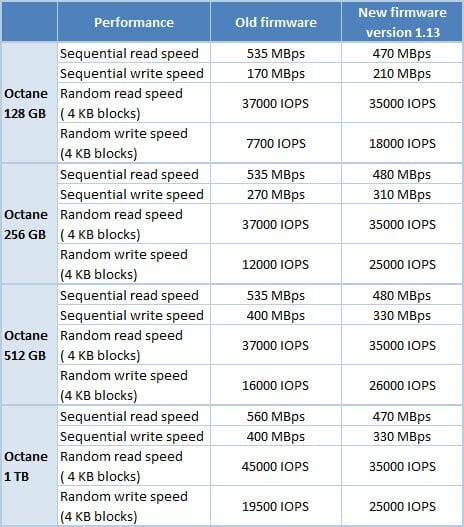
Increasing the speed of random-address writing was the main goal the new firmware was meant to achieve because the Octane series was inferior to competitors in this respect. Well, the Octane remains slower than SandForce SF-2281 based SSDs even now, yet the improvements are obvious anyway. Unfortunately, the speed of sequential access has lowered with the top-capacity models, but OCZ thinks that’s an acceptable tradeoff.
To check out the effect of the new firmware we used AS SSD. It is a good preliminary benchmark.
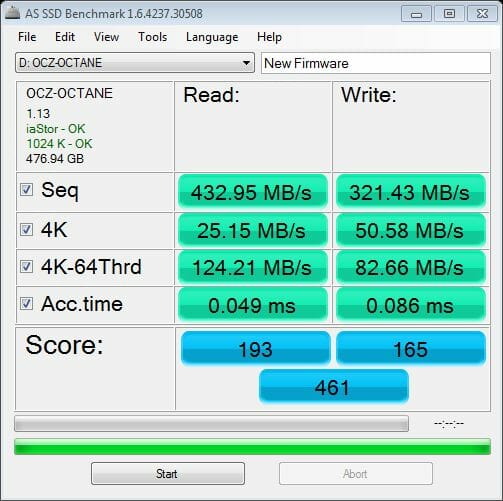
Well, the practice agrees with the theory. The speed of sequential reading and writing has become somewhat lower but the writing of 4 KB data blocks has improved greatly, up to 65% at a long queue depth. The Octane could be viewed as optimized for large amounts of sequentially placed data (this could come in handy in video editing applications, for example) but now it has become more versatile, even though still breaks no performance records.
You should be warned that the firmware update process is destructive in the sense that it destroys all user data. But it is surely worth the trouble.
In the practical tests of the OCZ Octane below we will use firmware version 1.13, the latest version available at the current moment.
Performance
Random and Sequential Reading/Writing with a “Fresh” SSD
We benchmark the speed of random- and sequential-address reading and writing with CrystalDiskMark 3.0.1 test. This benchmark is convenient to work with as it can measure the speed of an SSD with both random incompressible and fully compressible recurring data. So, there are two numbers in the diagrams below that reflect the maximum and minimum SSD speed. The real-life performance of an SSD is going to be in-between those two numbers depending on how effectively the SF-2281 controller can compress the data.
The performance tests in this section refer to SSDs in their “fresh” out-of-the-box state (FOB). No degradation could have taken place yet.
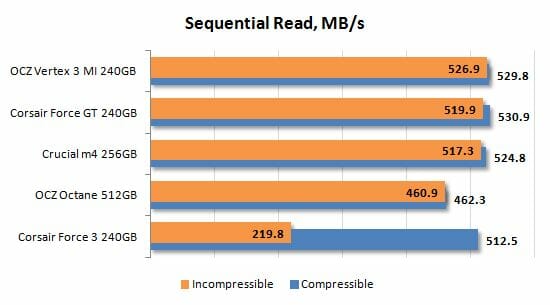
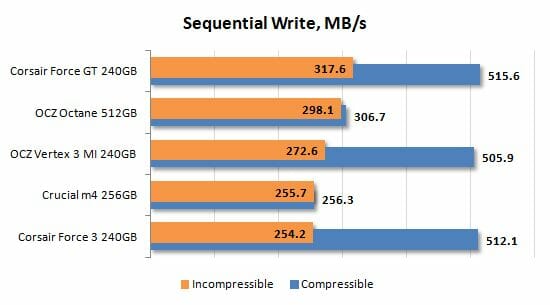
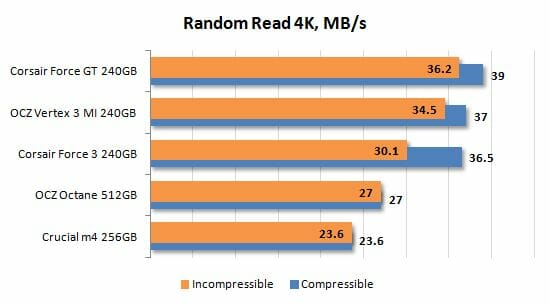
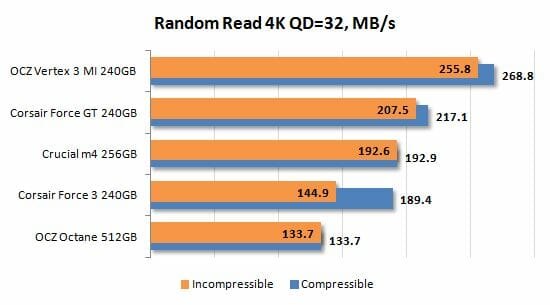
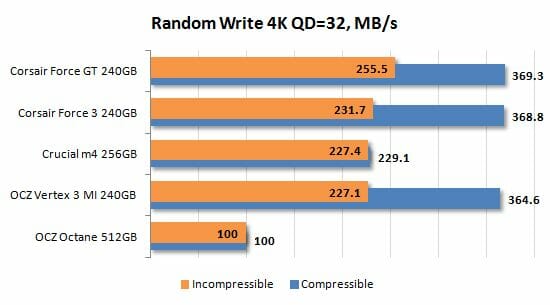
The first numbers make it clear that the OCZ Octane is completely different in its behavior from both the SandForce-based products and the Marvell-based Crucial m4. On one hand, the Indilinx Everest controller does not compress data and thus delivers the same performance irrespective of whether the data are compressible or not. On the other hand, the Octane cannot beat its opponents with any type of disk operation despite all the optimizations in its new firmware. It is very good at sequential writing but inferior to the SandForce-based SSDs elsewhere. Moreover, the Octane is downright uncompetitive with 4KB data blocks and even falls behind the Corsair Force 3 which is equipped with cheap asynchronous flash memory.
The CrystalDiskMark results do not show the Octane to be a total failure, though. Its value will depend on its usage scenario. Obviously, it won’t be a good choice as a small system disk or as a server disk subsystem which has to have a low response time and a high speed of processing small data blocks. OCZ doesn’t actually target the Octane at such applications. The emphasis on high storage capacity means that OCZ positions it as a full HDD replacement in a desktop PC, as a single disk that is used for storing user data among other things. In this scenario, the Octane can indeed make sense as it delivers a good performance at sequential writing.
Degradation and Sustained Performance
Unfortunately, SSDs are not always as fast as in their “fresh” state as they should be. In most cases their performance goes down after some time and in real life we deal with completely different write speeds than what we see on the diagrams in the previous chapter of our review. The reason for this phenomenon is the following: as the SSD runs out of free pages in the flash memory, its controller has to clear memory page blocks before saving data into them, which causes substantial delays. On the other hand, modern SSD controllers can alleviate the performance hit by erasing unused flash memory pages ahead of time, when idle. They use two techniques for that: idle-time garbage collection and TRIM.
Of course, users are more interested in the consistent performance of their SSDs over a long period of time rather than the peak speed they are going to see only during the initial short-term usage period. The SSD makers, however, declare the speed characteristics of “fresh” SSDs for marketing reasons. That’s why we decided to test the performance hit that occurs when a “fresh” SSD becomes a “steady” one.
To get a complete picture of SSD performance degradation we ran special tests based on the SNIA SSSI TWG PTS (Solid State Storage Performance Test Specification) methodology. The main idea of this approach is to measure write speed in four different cases. First we measure the “fresh” SSD speed. Then we measure their speed after the SSD has been fully filled with data twice. The third test occurs after a 30-minute break during which the controller can partially restore performance by running the idle-time garbage collection. And finally, we measure the speed after issuing a TRIM command.
We ran the tests in synthetic IOMeter 1.1.0 RC1 benchmark, where we measured random write speed when working with 4 KB data blocks aligned to flash memory pages at 32 requests queue depth. The test data were pseudo-random.
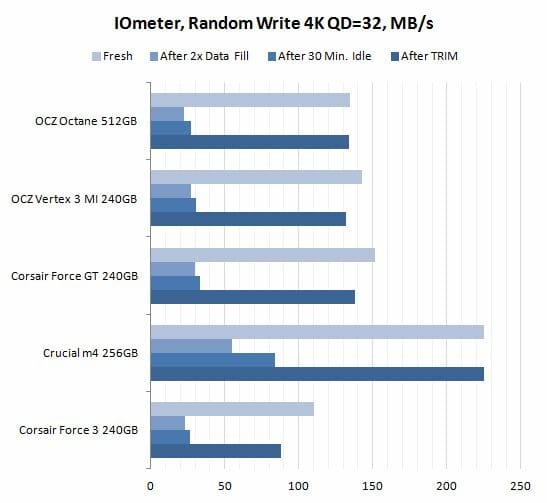
According to our earlier tests, SSDs with second-generation SandForce controllers are more susceptible to performance degradation than, for example, their Marvell-based counterparts. The Octane doesn’t bring anything new in this respect. Its performance drops by a factor of 6 as it gets filled with data. The garbage collection technique doesn’t prove to be effective because the reserve pool is small at only 7% of the total storage capacity. The TRIM command, on the contrary, brings the Octane back to life. The Everest can boast an excellent TRIM implementation as the performance of the SSD returns to its original level. The Indilinx developers have managed to beat their SandForce counterparts in this respect.
TRIM improves our impression of the Octane’s speed. The write speed results you have seen in the previous section are only reflective of the performance of the SSDs in their “fresh”, out-of-the-box state. But as they get filled with data and become “used”, their performance can change. The write speed of the used SSDs, as measured with CrystalDiskMark 3.0.1, is shown in the next diagrams.
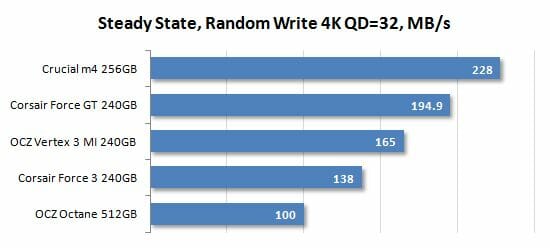
The SandForce-based SSDs slow down after a while and cannot be returned to their original speed even with the TRIM command, yet the overall picture doesn’t change. The Octane is so slow at processing small data blocks that even its perfect TRIM implementation cannot save the day. It does enjoy an even larger advantage at sequential writing, though.
Futuremark PCMark 7
PCMark 7 contains an individual disk subsystem benchmark. It is not a synthetic test, but is based on real-life applications. This benchmark reproduces typical disk usage scenarios and measures how fast they are completed in popular applications. Moreover, the disk access commands are not executed as a steady uninterrupted flow, but in a more realistic manner – with certain pauses caused by the need to process the data. The benchmark generates an overall disk subsystem performance rating as well as speed readings in MB/s in particular usage scenarios. Note that the absolute speed in these scenarios is not too high because of the above mentioned pauses between individual input/output operations. In other words, PCMark 7 shows you the speed of the disk subsystem from the application’s point of view. Numbers like that show us not only the pure performance of an SSD, but mostly how big of a performance gain a certain SSD can guarantee in real life.
We ran PCMark 7 on “steady” SSDs, which is what they are going to be in actual computer systems most of the time. Their performance is in this case affected not only by their controller or flash memory speed but also by the efficiency of their internal algorithms that fight performance degradation.
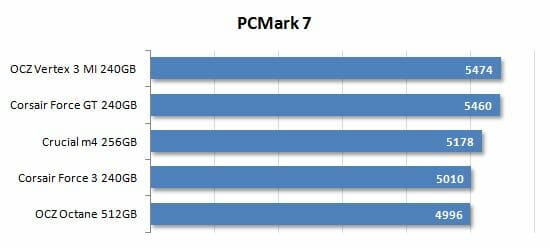
The PCMark 7 score is a good guide for users who want to see how SSDs perform in typical applications without delving into technical details. The score of the Octane isn’t high. It is lower than every other product’s, including the SandForce-based model with asynchronous NAND flash. All of this indicates that the Octane is not a good choice as an all-purpose SSD. Its average performance is lower than that of other modern products with SATA 6 Gbit/s.
It doesn’t mean the Indilinx Everest controller can’t deliver excellent results now and then. You can make sure of that by checking out the individual tests:
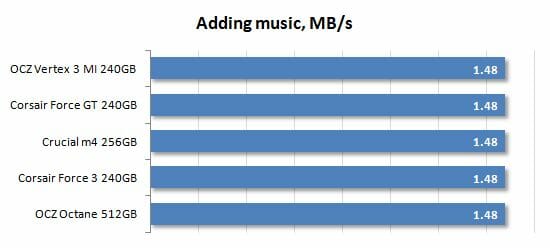
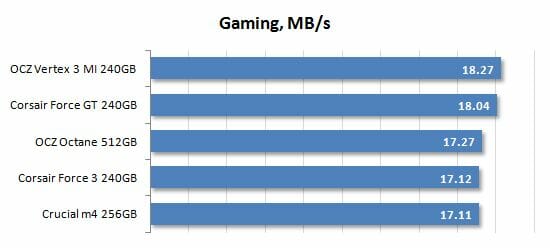
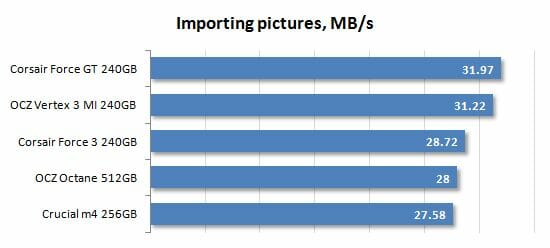
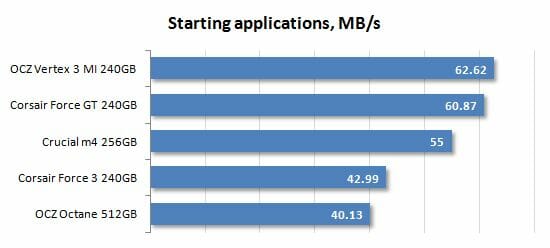
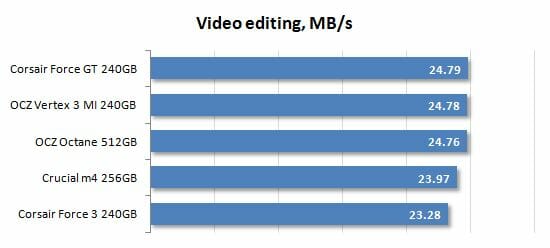
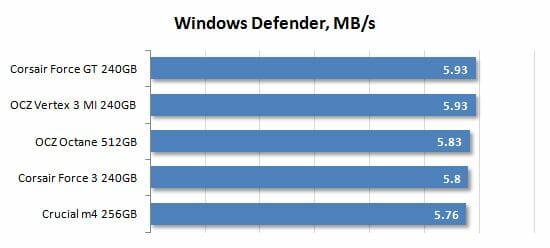
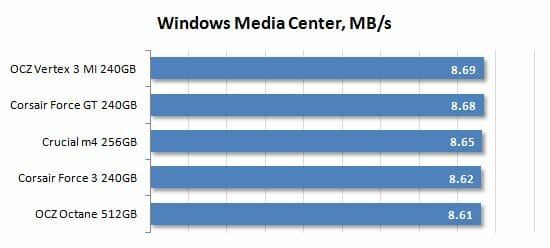
Video editing is an especially favorable scenario for the OCZ Octane as it calls for high performance with sequentially located data. Otherwise, the Octane is far from brilliant, its speed being comparable to that of the Corsair Force 3, an inexpensive SandForce-based SSD similar to such models as OCZ Agility 3 or Patriot Pyro.
Intel NAS Performance Toolkit
Like PCMark 7, Intel NASPT reproduces predefined disk activity traces and measures how fast they are executed. However, the default traces are designed for network attached storage devices rather than for SSDs. Therefore we employ the specially developed SSD Benchmarking Suite which offers more relevant usage scenarios such as compressing and uncompressing files, compiling large projects, copying files and folders, loading 3D game levels, installing software, batch-processing photos, searching a digital library for data, mass-launching applications, and transcoding video.
Like PCMark 7, this benchmark gives us a true-to-life illustration of a disk subsystem’s performance. Like in the previous case, the SSDs are benchmarked in their “used” state.
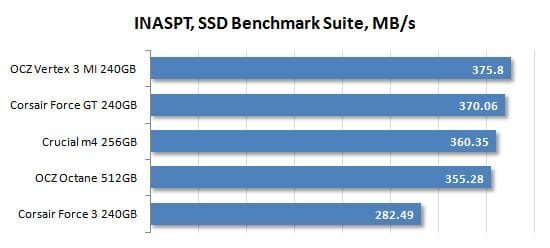
INASPT estimates the Octane’s performance higher than PCMark 7. Although the Octane cannot match the SandForce-based products with synchronous ONFI or Toggle NAND memory, it can at least compete with the slower representatives of the SandForce platform. In fact, the Octane can be viewed as an alternative to the Crucial m4 which is quite a popular product. We have no doubt it can get popular, too, as it does have a few winning features.
For example, INASPT reveals several usage scenarios where the Everest-based SSD is preferable to its opponents.
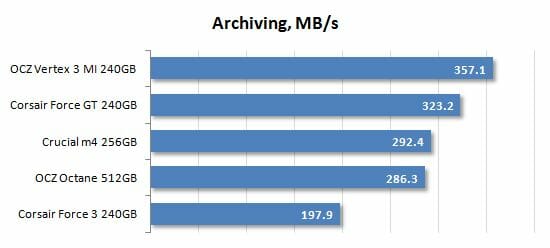
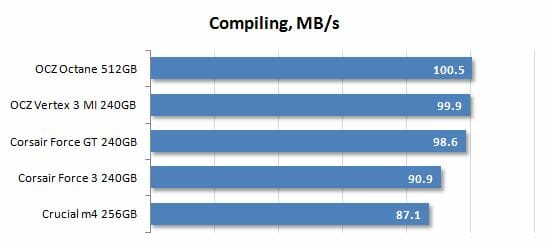
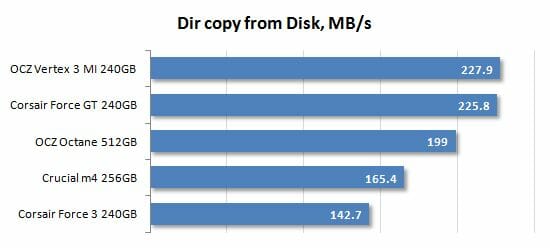
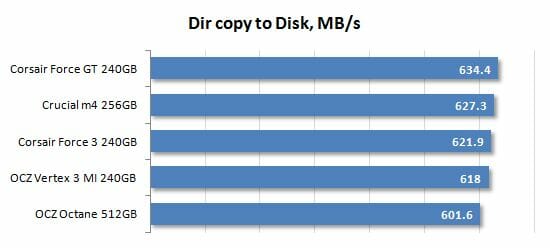
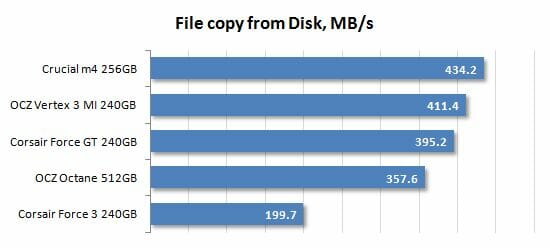
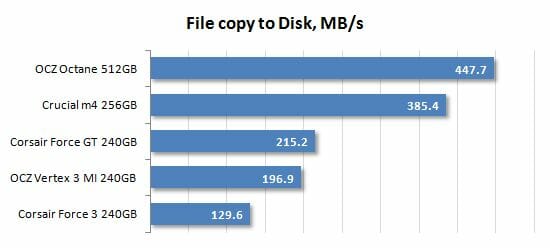
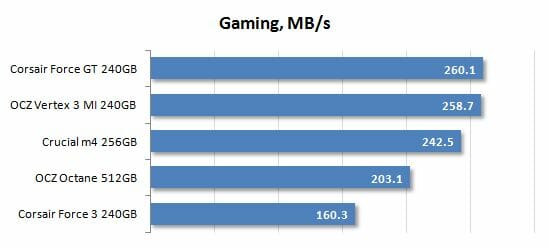
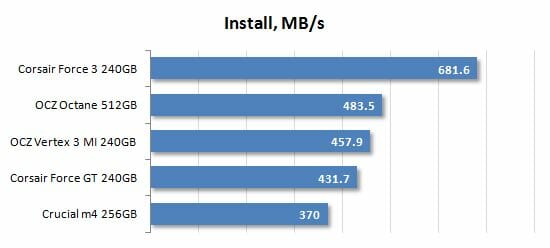
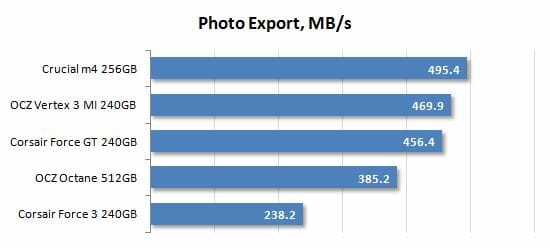
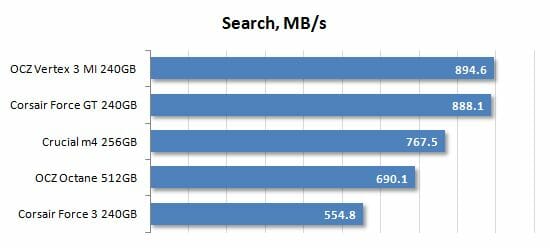
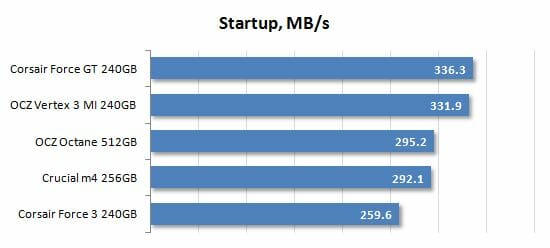
The Octane is good at transcoding video and at installing and compiling software. If that’s what you spend a lot of time doing on your computer, you may want to consider using an Octane as your disk subsystem.
Conclusion
The OCZ Octane cannot blow you away with its performance. It is inferior to the latest SandForce- and Marvell-based SSDs across most of real-life tests. The synthetic benchmarks provide the explanation: the Octane is too slow at random-address operations. The new firmware (version 1.13) has improved that parameter, yet not as much as to make the Octane drive competitive.
It doesn’t mean we are unhappy with the Octane. It really has its highs. It is fast at sequential operations, for example, which makes it suitable for such applications as video editing and software development. Another important advantage of the Octane series is that it includes large-capacity SSDs of 512 GB and 1 TB. There are virtually no other SATA 6 Gbit/s SSDs with such capacities now.
Unfortunately, the pricing of the Octane series is somewhat too high currently. This refers both to the large- and low-capacity models. The manufacturer must be trying to capitalize on the fact that it is a brand new and truly unique product rather than through rational arguments.
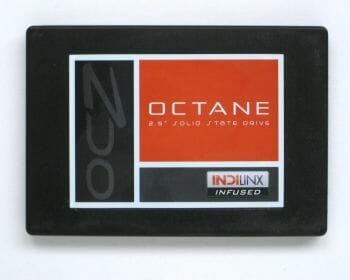
However, OCZ’s new SSDs based on the Indilinx Everest controller should also be viewed from a global standpoint. It is the company’s first step towards developing their own SSDs from scratch. And also a step away from the past collaboration with SandForce which was marred by various problems. The exclusive partner status of OCZ allowed it to introduce new SandForce-based products ahead of other makers but the company also took the biggest share of the criticism against the shortcomings and deficiencies of the SandForce platform. Moreover, OCZ has eventually become just one of a number of brands that offer absolutely identical SandForce-based SSDs.
So now OCZ seems to be going to give up SandForce-based products in favor of controllers from its own subsidiary Indilinx. The Octane is the first try, and a very good one at that. The new SSD has up-to-date specs and good performance. Most importantly, the Octane came out stable, reliable and problem-free. Now that OCZ has successfully debuted in the premier league of SSD makers who develop their own controllers, we are looking forward to the next generation of the company’s products based on improved Indilinx Everest 2 controllers. As far as we know, they are going to come about as soon as this summer.